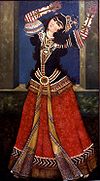Baharestan Carpet
| Part ofa serieson the |
| Culture of Iran |
|---|
 |
|
|
TheBaharestan Carpet,orBahār-e Kasrā(Persian:بهار کسری,fromMiddle PersianVahār-i Khosrow;meaning "The spring ofKhosrow"), also known asFarš-e zamestānī( "Winter carpet" ), andBahārestān( "Spring garden" ), was a large, lateSasanianroyal carpet, that is now lost, but is known from historical accounts. It most likely covered the floor of the great audience hall ofTaq Kasra,aniwanin the Sasanian capital ofCtesiphon.
The carpet was 27m long and 27m wide. Woven of silk, gold, silver, and rare stones, the carpet depicted a splendid garden akin to paradise.[1]
When Ctesiphonfellto theArabsin 637, the carpet was too heavy for theIraniansto carry away, which resulted in the carpet being seized by the Arabs.Sa'd ibn Abi Waqqas,who led the Arab troops during the capture of Ctesiphon, sent the carpet to theRashiduncaliphUmar,who was inMedina.There the carpet was cut into small fragments and divided among the Arabs. One of the Arabs who received a piece of the carpet wasAliwho, although he did not receive the best piece, managed to sell it for 30,000dirhams.[2][3]
See also
[edit]References
[edit]- ^Musical Observations, Inc."CP2 102 Morton Feldman & Artur Schnabel".Musicalobservations.Retrieved2013-07-08.
- ^Morony 1988,p. 479.
- ^Yarshater 1985–2007,v. 12: pp. 29-36.
Sources
[edit]- Yarshater, Ehsan,ed. (1985–2007).The History of al-Ṭabarī(40 vols).SUNY Series in Near Eastern Studies. Albany, New York: State University of New York Press.ISBN978-0-7914-7249-1.
- Morony, M. G.(1988)."BAHĀR-E KESRĀ".InYarshater, Ehsan(ed.).Encyclopædia Iranica, Volume III/5: Bahai Faith III–Baḵtīārī tribe II.London and New York: Routledge & Kegan Paul. p. 479.ISBN978-0-71009-117-8.
